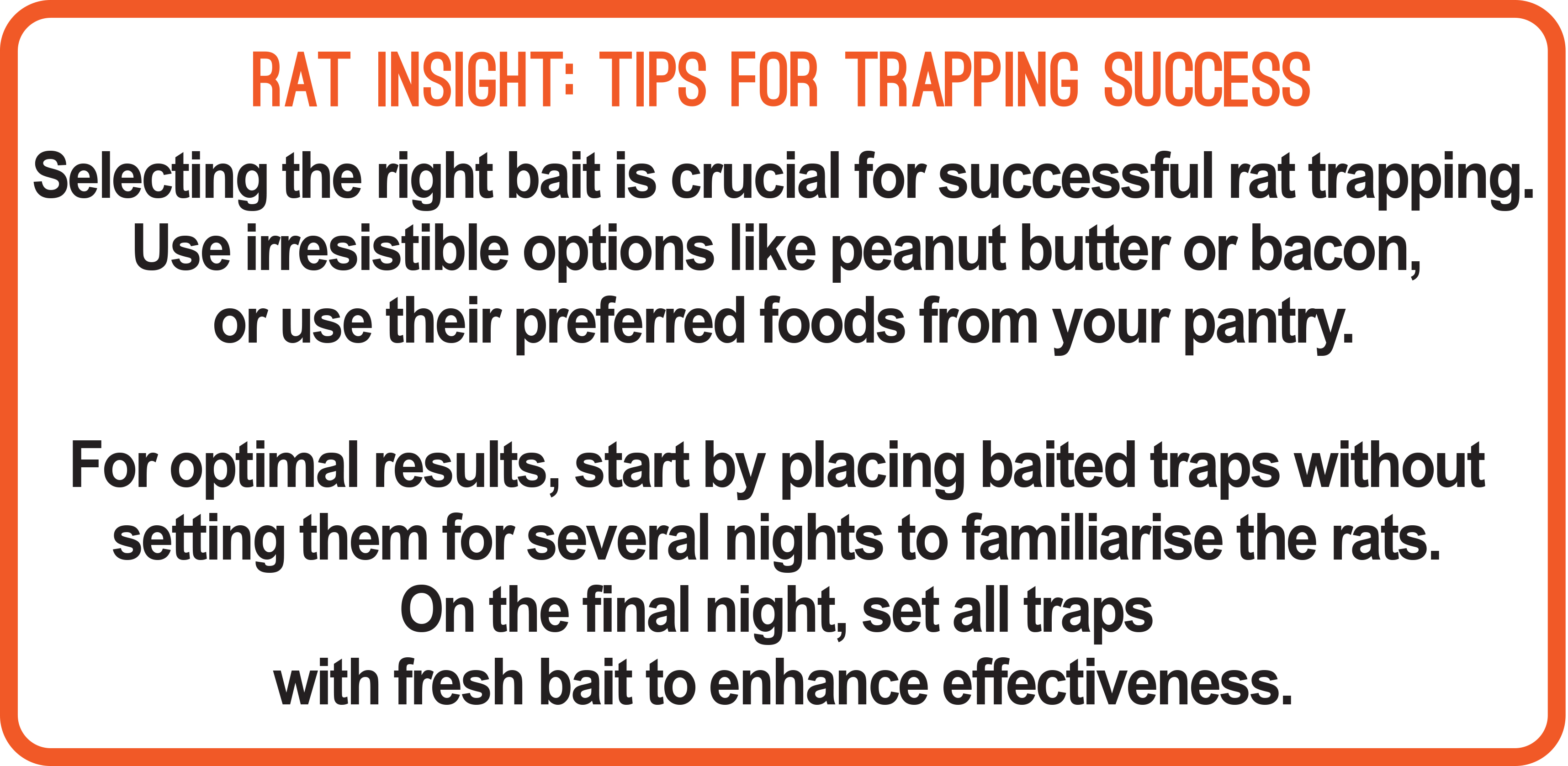
Rat traps have long been a trusted method for combating these unwelcome guests, Dealing with a rat infestation can be a daunting task.
In this in-depth guide, we will walk you through the critical aspects of rat traps, from the types available to expert tips on setting and baiting them effectively.
Rat raps are not a solution to outdoor rats and, for the most part, only have efficacy if you have one or two living indoors. Rat baiting is still the most efficient solution for a rat infestation.

Table Of Contents:
- Identifying Rat Infestations
- Rat Traps: A Delve Into the Different Types
- Rat Traps and How to Set Them
- Bait Selection
- Rat Traps Placement Strategies
- Safety Considerations
- Maintenance Tips
- Troubleshooting Issues
- Professional Assistance
- Rat Traps Frequently Asked Questions
- Conclusion
Identifying Rat Infestations
The first sign of a rodent problem is usually droppings or signs of gnawing.
Listen for scratching noises, especially at night. Rats are shy and tend to be most active when the threat of interruption by humans or their pets is minimal.
You may also spot footprints or tail marks in dusty areas. If these appear fresh, it suggests an ongoing problem.
Burrows around your property? That's another red flag. So are unusual pet behaviours - cats and dogs often react to rats before humans notice them.
Related
- Rat Identification: Signs of Rodent Activity.
- Possum Noises: A Guide to Species Identification.
- What Do Possums Eat and Possum Poop: Identifying Factors.
Rat Traps: A Delve Into the Different Types
Rat traps and mouse traps vary greatly, each designed to suit different needs. They can be broadly categorised into these main types: snap traps, live catch traps, and electronic rat traps. There are also lesser known rat traps such as; rat glue traps also known as sticky rat traps and bucket rat trap These all require you to manage the dead rats after they have been caught or killed with varying degrees of "ick" factor.
Snap Traps
Snap traps, the oldest type, use a spring-loaded bar to kill rats instantly. Effective but gruesome; not for the squeamish.
Live Catch Traps
If you're after a no-kill solution, a humane rat cage is your best bet. These let you release these rodents unharmed away from your property, leaving you open to a reinfestation if they breed or you don't take them far enough away from your house.
Electronic Rat Traps
Last up is the electric rat trap. A quick jolt of electricity in theory, kills them instantly.
Good Nature Rat Traps
A Goodnature rat trap require the rat to place their head into the trap, where a gas-driven strike bar bolt mechanism kills them instantly. This is a humane rodent control method with no poisons; make sure you don't put your fingers inside the shaft! It also comes with an app that lets you know it's killed a rat so you can clear the body
Rat Traps and How to Set Them
Getting rat traps catch ready is not just about setting and leaving them. Prepping properly is key for obtaining the optimal outcome when setting rat traps.
To start, clean your hands thoroughly before handling a trap. Rats have an acute sense of smell and can detect human scent, which may deter them from approaching the trap.
You also need to ensure that the trigger plate is sensitive enough so it doesn't miss any curious rats. Adjusting sensitivity might take some practice, but it's worth mastering this skill for effective trapping.
Bait Selection
Choosing the right rat baits can make a world of difference in your rat-trapping efforts. The key is to use something that rats find irresistible.
Rats often favour food items like peanut butter or bacon; alternatively, if they always eat the same foods in your cupboards, use what you know they love already.
Related
Rat Traps Placement Strategies
Identifying the best location to set your rat traps can be crucial. Remember, rats like areas that offer safety and cover. So, think about places such as behind furniture or appliances, along walls or in hidden corners.
You'll want to set up multiple traps in these spots because one alone may not do the trick. As they say - there's never just one rat. And don't forget to wear gloves when handling traps; it helps prevent human scent from deterring our furry foes.
Using traps is a process; the first step is to place all the traps with your chosen food as bait without setting them for several nights until the rats consistently eat the bait. On the final night, set all the traps with new bait.
Note If the rats are outside or in your roof they will bypass the traps due to an abundance of food available.In these instances, a bait station strategy is the best solution

Safety Considerations
Handling rat traps calls for care. To avoid harm, use gloves when setting and disposing of the trap.
It's not just about your safety but also public health. Rats can carry diseases like leptospirosis and typhus fever, so be cautious.
Finally, remember to keep traps away from pets and children. These simple steps will help maintain a safe environment while dealing with rats.
Maintenance Tips
Regular upkeep of your rat traps is vital to keep them effective. Firstly, always clean the trap after each use. This gets rid of any smells that might warn other rats.
Check regularly for wear and tear, too. Damaged traps can become less efficient or even fail completely.
Finally, don't forget about storage. When not employed, maintain your traps in a dry area to stop them from corroding.
Troubleshooting Issues
So, you've set your rat trap, and yet, it's not catching anything. Frustrating, isn't it? Don't give up hope yet.
Firstly, check if the bait has been taken. If so, you might need to secure it better next time. Try using a strong-smelling cheese or peanut butter - rats can't resist them.
If the trap is still full of bait but hasn’t sprung, consider its location. Rats are smart creatures who won’t venture into open spaces easily for fear of predators.
You may also find that some parts have broken due to wear and tear or mishandling during the setup or disposal.
Remember this: patience is key when dealing with rat infestations.
Professional Assistance
Handling rat infestations can be tricky, but getting help from a professional pest control service makes it easier. They're experts at managing more serious or hard-to-control situations.
Rats are crafty creatures and may avoid traps not set up correctly. A pro knows to place and bait traps effectively for results; they might also suggest a treatment plan using poison baits. Plus, they'll give tips on how to prevent future infestations.
Related

Rat Traps Frequently Asked Questions
What is the most effective rat trap?
Snap traps are often promoted as highly effective due to their ability to kill rats instantly and reduce suffering. Although they can be messy to clean up, as they are low cost, you might want to throw the whole thing away, including the rat, in a double bag in your weekly council rubbish pick up.
What rat traps do professionals use?
Professionals are less likely to use traps and have a preference for bait. Traps are not the most cost-effective solution for their customers due to having to re-bait the traps every night for 7-10 days before they finally set them, which would be an incurred cost of a daily call-out fee for the customer.
Do rats know to avoid rat traps?
Rats are very suspicious of new things in their environment they will take a few days or weeks to be comfortable enough to investigate further. However, they don't know to avoid them because of the inherent knowledge they are in danger.
What is the best deterrent against rats?
Maintaining cleanliness, sealing entry points in your home, and using ultrasonic devices can help deter rats effectively.
What food are rats most attracted to?
Rats tend to be drawn towards high-protein foods like peanut butter, meat scraps or even chocolate.
How effective is Ratsak?
Ratsak can be quite potent when used correctly. It's a bait that causes internal bleeding in rodents, leading to death. In some cases, rats have been known to have immunity; if it has little to no effect, it is a good idea to enlist the help of a professional with access to industrial-grade baits.
Conclusion
Rat traps strategic placement techniques are vital, and always prioritise safety. Follow our precautions when handling these devices.
With the information above you can now confidently identify infestations and select suitable trap types. Our expert tips will help your setup process, and remember; the bait is your secret weapon.
Regular maintenance will ensure your rat traps function efficiently. Should you encounter any issues, or If the situation escalates, seeking professional assistance is advised for effective control.
More Possum articles you may like:
- Possum Deterrents vs Repellents: What's Effective?
- Dead Possum Dilemma: Removal and Prevention.
- Possum: Proven Deterrent and Removal Methods.
- Gutter Guard & Valley Guard Solutions for Possum Prevention.
- Tree Guard: The Essential Guide.
- Possum Box Installation: A Guide to Suitable Habitats.
- Possum Removal: How to Get Rid of Possums Permanently.
- Possum Removalists: How to Choose the Right Expert.
- Possum Trap: Essential Do’s and Don’ts for Success.
- Catch and Release Licences: How to Remove Possums Legally.



